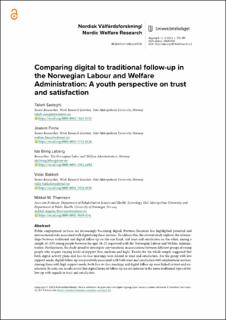| dc.contributor.author | Sadeghi, Talieh | |
| dc.contributor.author | Finne, Joakim | |
| dc.contributor.author | Løberg, Ida Bring | |
| dc.contributor.author | Bakkeli, Vidar | |
| dc.contributor.author | Thørrisen, Mikkel Magnus | |
| dc.date.accessioned | 2024-01-03T13:05:02Z | |
| dc.date.available | 2024-01-03T13:05:02Z | |
| dc.date.created | 2023-12-05T10:23:49Z | |
| dc.date.issued | 2023 | |
| dc.identifier.citation | Nordisk välfärdsforskning | Nordic Welfare Research. 2023, 8 (3), 178-191. | en_US |
| dc.identifier.issn | 2464-4161 | |
| dc.identifier.uri | https://hdl.handle.net/11250/3109570 | |
| dc.description.abstract | Public employment services are increasingly becoming digital. Previous literature has highlighted potential and intersectional risks associated with digitalizing these services. To address this, the current study explores the relationships between traditional and digital follow-up on the one hand, and trust and satisfaction on the other, among a sample of 1195 young people between the ages 18–25 registered with the Norwegian Labour and Welfare Administration. Furthermore, the study aimed to investigate any variations in associations between different groups of young people who require varying levels of support (low, medium and high). Results for the whole sample suggested that both digital activity plans and face-to-face meetings were related to trust and satisfaction. For the group with low support needs, digital follow-up was positively associated with both trust and satisfaction with employment services. Among those with high support needs, both face-to-face meetings and digital follow-up were linked to trust and satisfaction. In sum, our results reveal that digital forms of follow-up are not inferior to the more traditional types of follow-up with regards to trust and satisfaction. | en_US |
| dc.language.iso | eng | en_US |
| dc.relation.uri | https://www.idunn.no/doi/10.18261/nwr.8.3.2 | |
| dc.rights | Navngivelse 4.0 Internasjonal | * |
| dc.rights.uri | http://creativecommons.org/licenses/by/4.0/deed.no | * |
| dc.title | Comparing digital to traditional follow-up in the Norwegian Labour and Welfare Administration: A youth perspective on trust and satisfaction | en_US |
| dc.type | Peer reviewed | en_US |
| dc.type | Journal article | en_US |
| dc.description.version | publishedVersion | en_US |
| cristin.ispublished | true | |
| cristin.fulltext | original | |
| cristin.qualitycode | 1 | |
| dc.identifier.doi | 10.18261/nwr.8.3.2 | |
| dc.identifier.cristin | 2208986 | |
| dc.source.journal | Nordisk välfärdsforskning | Nordic Welfare Research | en_US |
| dc.source.volume | 8 | en_US |
| dc.source.issue | 3 | en_US |
| dc.source.pagenumber | 178-191 | en_US |

